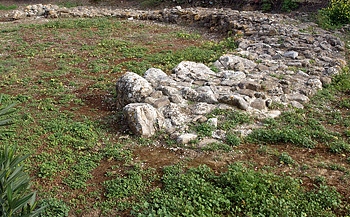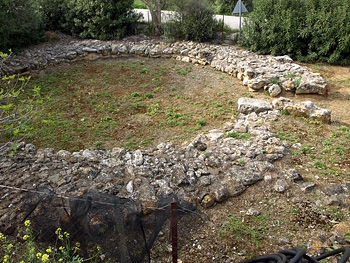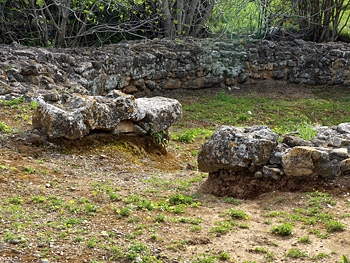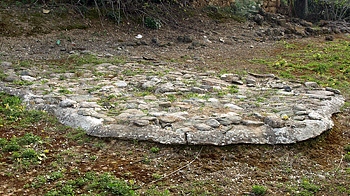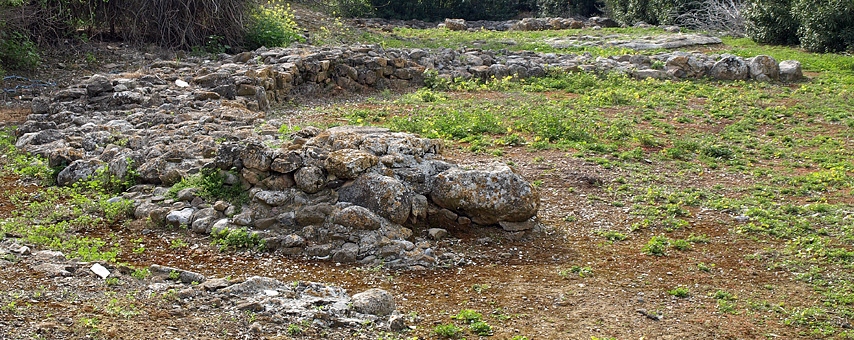
A large cemetery complex
The cemetery at Platanos was excavated by Xanthoudides in 1914-5 after locals, digging the foundations of a church they wanted to build, came across the remains. The cemetery is located on the edge of Platanos village. A large part of the cemetery has since been lost. A modern road now passes through the middle of the cemetery and everything to the south of the road, including Tholos Gamma and the various other structures adjacent to it have disappeared as the fields have been regularly cultivated. What remains is not in good condition, but originally the cemetery consisted of three tholos tombs, A, B and Gamma. Tholoi A and B are the largest yet found in the Messara.
Tholos A
During the hundred years before the excavation many stones had been removed from the site of the cemetery for use in construction. Consequently half the circuit of Tholos A on the east side, including the doorway and antechamber were destroyed. The inner diameter of the tomb was 13.10 m, and the thickness of the wall averaged 2.40 m. The external diameter therefore reached 18 metres, making it the largest tholos yet found. The doorway at the east entrance is missing and the antechamber was destroyed when a path was created that passed between Tholos A and Tholos B.
The burial stratum was about half a metre thick and consisted of two layers. The top layer consisted of the bonding clay which had been washed out from between the fallen stones. In this layer bones were found as well as the finer objects recovered from the tomb. This included bronze daggers of the long type and gold ornaments. The lower stratum contained few bones and few finds, among them daggers of the triangular type. This layer had been plundered and the finds consisted of what the plunderers missed or didn't care for.
Fires had been lit in various parts of the tomb, and particularly in the centre. Xanthoudides was perplexed by this as the fires had clearly been strong enough to fuse stones and metal objects but it did not appear that the fires had been used to cremate bodies.
Immediately to the east of Tholos A there were some small structures which formed an annexe to the tholos. Many bodies had been buried here and the rooms also contained hundreds of small stone vases. On the south side of the circuit wall, some external walls were found, which looked to Xanthoudides like buttresses. A number of burials had taken place among these walls but the poor quality of the grave goods suggests that only poor people or slaves, if they existed, were buried here.
Between Tholos A and Tholos B an area (AB) had been paved over with slabs of green slate laid on a foundation of stones and clay. West of that, towards Tholos B some walls were found which may have belonged to an antechamber and annexe for Tholos B. These rooms would have been used for burials or for storing stone vessels. Bones and stone and clay vases were found in this area. To the south of the paved over area and these walls, another wall running east-west from the wall of Tholos B to the beginning of the paved area may have enclosed this area.
Tholos B
Tholos B was very partially restored by Xanthoudides to repair the damage caused by the locals digging there in 1914. The inner diameter of the tomb is 10.23 m, while the average thickness of the wall is 2.45 m, giving an external diameter of over 15 metres. Xanthoudides collected up the fallen stones in an effort to calculate how much of the tomb would have been corbelled. His conclusion was that the whole of the tomb would have been corbelled with a small aperture at the top which would have been covered with a stone that could be removed to allow in light or ventilation or allow out smoke from fires lit within the tomb. In the south part of the outside wall there had been twenty four projecting slabs in a row, of which twenty still remained in place. They were positioned just over half a metre from the ground and half a metre apart.
The burial stratum varied in thickness from 0.30m to 0.90m There was no sign of burning and the bones were in very poor condition. A large number of skulls had been placed in the southern part of the tomb. Xanthoudides believed that Tholos B was built centuries later than Tholos A and that it remained in use for centuries, during which time its contents were systematically looted, as the finds were of much poorer quality than those of Tholos A.
Tholos Gamma
Tholos Gamma was found a few metres north of Tholos B and it had been almost completely destroyed. Only the southern part was preserved, and that only to the height of the first course of stones. In the doorway only one upright remained in place and in front of the entrance traces of walls which presumably were once the annexe to this tomb could be seen. The internal diameter of the tholos was 7.30 m and the wall was 1.80 m thick. Some bones had been blackened by fire and others had not which suggests that, here too, fires had been lit in different parts of the tomb.
Other burial areas
Near Tholos Gamma some small square buildings, arranged in groups, and each of which consisted of several chambers, were found. After finding pieces of clay with impressions of reeds in them, he concluded that the house tombs had been roofed over with a mixture of clay and wood. In his view the house tombs had been used to bury the poor, presumably because there were very few funerary articles found inside the tombs. One group consisted of three rectangular buildings, each one three or four metres long and according to Xanthoudides were of a later date than the tholos tombs. Two long trenches, lined with stones where they had not been hewn out of the rock, contained bones and plain cups. Xanthoudides concluded that these were ossuaries where the bones from the tombs were deposited to make way for fresh burials. However, it is also possible they too were rectangular tombs,
Dating the cemetery
Dating of the cemetery complex is not easy. Based on pottery found within the tomb, Tholos A dates from the EM II period. Two strata were found inside the tomb, a lower one dating to EM II and a higher one dating to EM III-MM I. Xanthoudides thought that Tholos B was built in EM III. With Tholos Gamma the picture is less clear. Xanthoudides thought it had EM II origins but there is also evidence suggesting an EM III-MM I beginning.
Suggested construction dates for other areas are: Tholos A annexe, MM I-MM II; the rooms south of Tholos A, MM IB-II; rectangular tombs alpha and gamma, MM I-LM; the annexe to Tholos B, date unknown; Area AB, MM I. Platanos seems to have had two tholoi in use through to MM I as well as undergoing major new construction during EM III-MM I, a combination unique to this cemetery.
The finds
The finds in Tholos Alpha present a puzzle. Gold and daggers were found in the upper stratum and these belong to the EM III-M I period. Similar finds were uncovered in the annexe, giving its stratum the same date. However, the composition of the finds bears the hallmarks of EM II funerary deposits rather than EM III-MM I. A typical EM II funerary deposit would include objects made from gold or silver, objects with connections to the Cyclades or other parts of the Aegean, and very few seals and stone vessels. EM III-MM I deposits are more likely to contain only a small number of silver and gold objects but much larger quantities of seals and stone vessels. The finds in Tholos A upper stratum and the annexe seem to have much more in common with the first group than the second one. If this picture is true then Platanos is not at all typical of EM-MM cemeteries.
In Tholos B finds included 80 seals, 33 stone vessels and three scarabs in the Egyptian style. The large number of seals and stone vessels together with the scarabs indicate that the deposits here were much more like those one would expect in MM I layers in cemeteries. Two suggestions have been advanced to explain the differences in the finds from Tholos A and B. According to the first theory, two different clans may have each used one of the tholos tombs and the finds reflect the choices made by the two clans concerning what grave goods represented them best.
The second theory is that access to the two tombs was based on social position in Minoan society. The majority would be buried in one tomb and the elite in the other. If daggers were symbols of power and authority, then the 60 daggers found in Tholos A may mean that access to this tholos was limited to the elite.
Interestingly there was an absence of conical cups which are found in most cemeteries, especially ones where annexes have been constructed. At Tholos A, these seem to have been replaced by stone vessels. As changes in funerary practice took place in MM I and newly built annexes and paved courtyards made possible gatherings and rituals that were not previously possible, it seems that the people using Tholos Alpha put their own stamp on these rituals by using stone vessels rather than the conical cups found at most other similar sites.
SOURCES: The main sources for this article were "The Vaulted Tombs of the Mesara" by Xanthoudides and "Secret Lives of EM and MM cemeteries" by Legarra-Herrero.


